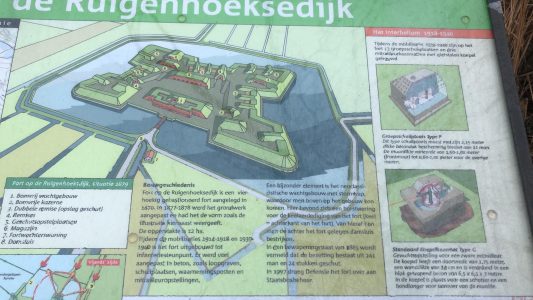Box 1:
The New Dutch Water Line
The New Dutch Water Line was the main defense line of our country from 1815 to February 1940. This line consisted of a chain of 50 forts, 6 fortified towns and 750 concrete group shelters, 88 military rifle casemates and many military locks.
An 85-kilometer-long Waterline ran through the middle of our country, from Muiden on the Zuiderzee to the Biesbosch near Werkendam.
The defensive action of the Line was a combination of the obstruction effect of flooded terrain with strong artillery and infantry action.
The area traced in blue could be flooded (inundated) to knee height. Enough to hinder the passage of foot soldiers and horses with guns and too shallow to navigate. The width of the water surface of approximately 5 km was greater than the maximum firing reach of artillery.
Forts and batteries have been built at specific sites where roads, railways and waterways cross the line at higher, non-inundable terrain strips. Manned with artillery and infantry, the forts prevented attackers from entering through these accesses.
The ever-increasing military competition and especially the rise of the airplane meant that this method of defense soon became obsolete. Nevertheless, the New Dutch Waterline was not definitively abolished until 1951.
Box 2:
Flora and fauna on the Ruigenhoek
The site has everything to form an ideal living environment for a varied flora and fauna.
The raised ramparts and slopes consist of different types of soil, both supplied from elsewhere and from the excavated moat. On the one hand fertile clay, on the other nutrient-poor sand, substrate for a very diverse vegetation.
The large oaks, ash and plane trees provide shelter and breeding opportunities for numerous birds, such as the blue heron, the nuthatch and the great spotted woodpecker.
The moat is filled with clean seepage water and rainwater and the rich fish population attracts cormorants, grebes and grass snakes. In the steep bank the kingfisher makes its nest cavity. ducks and coots breed in the fort moat. In the evening twilight the tawny owls go hunting in the wider area surrounding the fort.
The brick buildings are lushly covered with mosses and lichens, such as the ‘Oranje dooiers’ and the ‘Rond dambordje’.
A concrete group shelters provide a perfect living and wintering place for bats. The water, long-eared, and common pipistrelle have been observed.
Box 3:
Fort on Ruigenhoeksedijk, situation 1879:
- Bombproof guard building
- Bombproof barracks
- Double depot (gun storage)
- Depots
- Gun
- Warehouse
- Fort guard house
- Dam lock
Defense
The Fort on Ruigenhoeksedijk has been built at a junction of dikes. It served to close the access Ruigenhoeksedijk (1) and to defend the retaining quay between two inundation basins (2).
The fortress also controlled the Utrecht-Hilversum road and the adjacent railway (3).
The fort was part of an advanced ring of fortresses whose task was to protect Utrecht from an artillery bombardment.
Construction history
Fort on the Ruigenhoeksedijk is a quadrangular abstinent fort built in 1870. In 1877-1877 the earthwork was adjusted and it had the shape as shown in the illustration on the right. The surface is 12 hectares.
During the mobilizations 1914-1918 and 1939-1940, the fort was expanded into an infantry support point. Much was done in concrete, such as trenches, shelters, observation posts and machine gun emplacements.
A special element is the neoclassical guard building with storm roof, which allowed access to the top of the building. Here was a parapet for the throat defense of the fort (throat = back of the fort). From here it was possible to cover the dam sluice behind the fort.
In an armament statement from 1885 it is stated that the occupation consists of 241 men and 24 pieces of artillery.
In 1997 the Ministry of Defense handed over the fort to Staatsbosbeheer.
The Interbellum 1918-1940
During the mobilization 1939-1940, 13 group shelters and three machine gun casemates with cast steel domes were built on the fort.
Group Shelters Type P
This type of shelter had to be …
Standard Dome Casemate Type
Combat setup for a …

